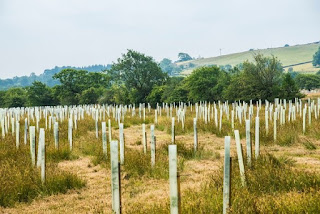The new
Chatburn-Downham Concessionary Bridleway
As many of you will have noticed, either through following
our social media channels or from travelling along the Chatburn Road to/from
Downham in the last 6 months, work has been on-going to create a new bridleway
connecting the two villages. Previously walkers, cyclists and horse-riders had
no choice but to use the road if they wished to travel from Chatburn to
Downham, which was a somewhat unsettling prospect given that vehicles are
permitted to travel up to 60mph there.
The Pendle Hill Landscape Partnership, with the support of
the Heritage Fund, the Forest of Bowland AONB and the Downham Estate,
are happy to announce the opening of the Chatburn-Downham bridleway which will
provide the public with a safe and scenic route between the villages.
Early stages
Those of you familiar with the Chatburn and Downham areas
will also be familiar with the prevalence of Roman history in the
area. An old Roman road is speculated to exist, buried, in the vicinity of
Downham/Rimington, a small section of which could potentially have overlapped
with the proposed line for the new bridleway. Therefore, before any work could begin, we asked Greenlane Archaeology Ltd to survey the site to prevent
any damage to any valuable archaeological evidence from Roman times. The survey
took place in early February 2020; as many of you will no doubt remember the
weather that month left a lot to be desired.
 |
A top layer of turf and soil is carefully removed in order
for the survey to begin
 |
During a break in the hail, which was detrimental to
visibility, archaeologists begin to examine the earth for signs of the old
Roman road
|
The new route also runs close to a number of trees. Where
ground works are located close to trees, protection of the roots must be
considered. Forester and Tree Surgeon Richard Davis was retained to survey the area
and calculate 'Root Protection Areas', which are used to determine the amount
of protective material required to lay over tree roots to prevent subsequent
ground works from damaging them. Terram and Geocell were used which ensures
the continuation of essential air and water flow to roots and helps to
distribute the weight of stone evenly, and this was installed below all sections of the bridleway where tree root protection had been identified as necessary.
Construction Begins
Following the laying of geotextile in the relevant areas,
ground works began in earnest. An area of ground was identified to ensure that
enough space was afforded for a 3m wide track, comfortable for two-way traffic,
with a further 2m of area suitable to support a hedgerow. A fence has been
installed down the entire length of the new bridleway in order to protect and
isolate the livestock in the adjacent field.
Initial work was slowed by the huge amount of rainfall we
experienced in February; the machines needed for construction could not safely
navigate such waterlogged ground without risking lasting damage to turf and
soil. However, after the ground had dried in early March fast progress was made
by Charlie Yirrell and his company CPY Excavations, beginning first on the 500m
stretch from Chatburn to Greendale View Kitchen. The line of the bridleway,
previously decided in consultation with the landowner, was excavated and a
solid stony foundation was laid. Further aggregate was spread on top of the
foundations then rolled flat. Subsequent good weather has baked the new track,
creating a sturdy surface for foot, bike and hoof traffic.
 |
Working carefully around standing trees, contractors lay a
surface to create the bridleway
|
The extended good weather through April and May allowed for
the making up of time lost in February. Then another curveball, the Covid-19
lockdown (from late March 2020), threatened to further slow construction.
However, CPY Excavations quickly adapted safe, socially-distant work plans and
risk assessments, and good progress was made regardless. By April, bridleway
construction moved well into the second 500m stretch, from Greendale View
Kitchen towards Downham.
By mid-May, track-work was complete and a new hedge, planted and watered through the drought by Ralph Assheton, is in position along the vast majority of the bridleway. Finishing touches were applied along the route, such as mounting blocks for horses, the installation of boulders for seating and a water-trough for thirsty horses.
The final works required to
make the bridleway a fully legal and safe was the installation of a series of
gates along the bridleway where the track nears an exit to the road. You may
spot the gates and at first be surprised by their spatial situation; they do
not, after all, meet and form a barrier as normal gates would. In addition to
prevent any attempted vehicular use of the bridleway, the main purpose of the
gates is to create a holding area a safe distance from the road, where horse
riders can see passing cars easily (and vice versa) before deciding to proceed
from the bridleway onto the road. Additionally, when viewed head-on, the two
separate gates will appear to a horse to be a single closed barrier, which will
prevent any spooked animal from bolting into the road.
 |
| A safe distance from the road, the gates create a chicane which affords horse riders and drivers more chance to see each other before a crossing is attempted. Photograph by Graham Cooper. |
 |
From a distance, a horse will perceive the gates as a
single obstruction across the track, preventing any bolting which may lead to a
road traffic accident. Photograph by Graham Cooper.
|
As of mid-June 2020, the Chatburn-Downham bridleway is
officially open to the public. We would like to encourage the safe and
considerate use of the new route. Please stick to the track to protect the
young hedgerow, pick up after your dog and take any litter home with you. Please enjoy the bridleway safely!
 |
| Images by Graham Cooper |













